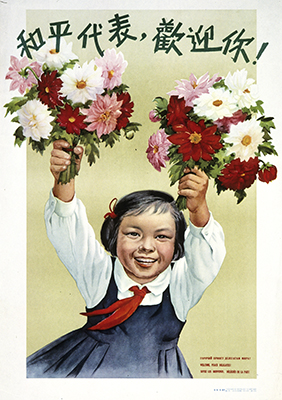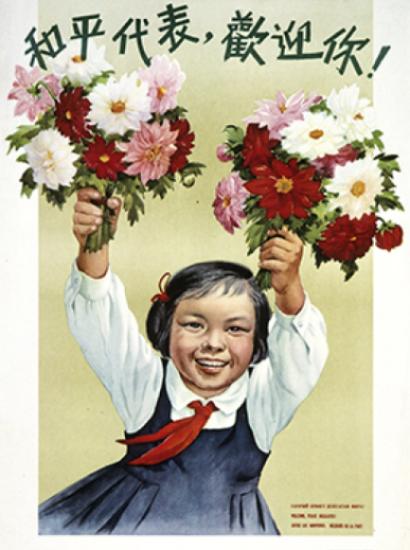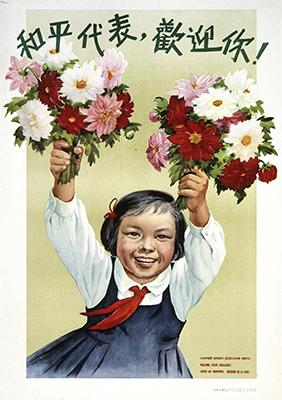- International Affairs
- Key Countries / Regions
- China

Among the container ships waiting for a berth at the port of Long Beach during the ocean-carrier traffic jam early this year were vessels of COSCO Shipping. The Chinese state-owned shipping company sails under the guidance of Captain Panda, a jolly stuffed-bear skipper decked out in crisp blue and gold nautical officer’s garb befitting the leader of one of the most powerful organizations of the Middle Kingdom.
But container shipping is not all fun and games. The vessels lined up off the West Coast of the United States carry boatloads—literally—of goods to resupply American consumers wearied by the yearlong lockdown that followed an earlier delivery from China that proved far deadlier even as its origin remains unconfirmed. A serious outfit dedicated to delivering value, the COSCO customer service approach that will get those goods into the U.S. e-commerce pipeline is on full display at shipping conferences, where company exhibit tables test the logistical acumen of potential customers with carefully crafted questions such as how many Captain Panda gift boxes can fit in one 40-foot shipping container?
Calculating that number is straightforward. Harder to quantify is what COSCO vessels really deliver: Captain Panda delivers Chinese power. COSCO vessels are the flagships of China’s maritime power, the critical logistical link between Chinese manufacturing zones and the empire of commercial ports and container terminals that this state-owned company has built since launching a container-shipping service in 1978.
The COSCO containership fleet is a propaganda victory of historic magnitude for China. While the blue hulls of Chinese fishing fleets attract negative attention about China’s territorial aggression in the South China Sea and the Pacific fishing grounds off the coast of South America, in stark contrast the blue hulls of COSCO container ships waiting in line to unload are seen as good news—a sign of the strength of American consumers, who must endure longer waits for the newest generation of connected treadmills and appliances for homes that are again being used for cooking during lockdowns.
The propaganda victory is that COSCO’s fleet is viewed as just one among the generic container lines that keep goods flowing from China and Southeast Asia, yet it poses a far greater danger to U.S. security than Chinese fishing vessels that are now routinely singled out as instruments of CCP aggression. This has allowed COSCO to achieve a more serious objective: under the guise of merely carrying cargo and taking on the responsibility to operate ports around the world, COSCO and several allied firms have in effect captured a network of shore installations from which to project Chinese influence into local and national governments that now depend on China not only for consumer goods and sensitive materials such as pharmaceuticals, but on Chinese state-owned companies to operate the critical infrastructure that connects them to the globalized economy.
China’s infrastructure holdings, secured by contracts with host governments, provide Chinese state-owned enterprises with a seat at the tables where political and economic decisions are made—which is the goal of propaganda efforts. It’s the culmination of a decades-long campaign that illustrates the most sophisticated use of propaganda techniques as described by Edward Bernays, the American innovator who transformed the principles of emotional manipulation codified by his uncle Sigmund Freud into the trade that we now call public relations. In his seminal 1947 essay, The Engineering of Consent, Bernays wrote that business and political leaders need to “recognize the significance of modern communications not only as a highly organized mechanical web but as a potent force.” The result of a communications campaign that is properly conceived and diligently executed, even over long time periods, will be that “the ideas conveyed by the words will become part and parcel of the people themselves.”
China spends billions on its propaganda ministry and an extensive apparatus of organizations to propagate the CCP’s values to foreign audiences through virtually every form of communication and direct interaction. But it is China’s global infrastructure build-out that operationalizes the CCP strategy to administer the world—because each infrastructure contract represents one more Western concession to Communist China: for example, a concession by debt-laden Greece that it lacked the public funds needed to pay for the modernization of its main port at the historic harbor of Piraeus, where the second-rate Spartan navy blockaded the supply chains of Athenians, forcing their surrender and the imposition of a puppet government to end the Peloponnesian War.
Governments exist to deliver a range of services to their citizens, and the delivery can often be outsourced to third parties, just as manufacturing jobs were outsourced to China and other countries where labor costs were far below what companies had to pay to workers in industrialized economies. Chinese propaganda telling the story of China as a responsible global leader, and offering an alternative to the American-led Western liberal order, is aimed at undermining the credibility of the Western governance system based on free markets and individual human rights—thereby making it easier for governments, companies, and citizens, to accept Chinese capital and ultimately Chinese administration of the delivery of services to citizens that had previously been handled by local or national governments.
Securing approval of the major public works that are the hallmark of China’s expansion is the frontier of political influence, the gray zone where China’s comparative advantage in infrastructure engineering comes into contact with the West’s perceived comparative advantage in liberal governance, where propaganda—public communication—can help advance China’s front line.
It might not be long before China rolls out new tools. A team led by researchers in Hong Kong has devised a new approach to building major public works based on the complex interactions among “stakeholders,” the citizens, regulators, activists, contractors, and public officials involved in large construction projects. The team studied how stakeholders had been managed on a major project to use new land-reclamation and dredging technology to build a 370-acre island adjacent to an unnamed city.
To better smooth the way for such projects, the team called for project sponsors to conduct what infrastructure engineers call “PCC”—public and community consultation—throughout the construction process rather than only in the early stages to win approval. In the context of China’s Belt and Road Initiative, and the expansion of ports, container terminals, and rail networks being undertaken by COSCO and its allies, the report is an invitation to conduct continuous propaganda—not merely advance communications lauding the theoretical benefits of Chinese investment, but ongoing advocacy and interaction with local stakeholders, treating them, in effect, as China’s new constituents. It’s a blueprint for engineering consent to the massive public works that only China is capable of building.
While large-scale infrastructure projects give China the most extensive links to local political influence in foreign countries—and present high-value targets for supporting propaganda campaigns—COSCO’s real skipper, Xu Lirong, who is chairman and Party Secretary at China COSCO Shipping Corp. Ltd., is alert to how even modest civic good works can advance larger goals. Last November, the Piraeus City Council voted to order COSCO to stop sending construction trucks through the city and require it to move heavy materials to the site by water, one of several efforts to delay the construction work COSCO had committed to in 2016 when it bought control of the port authority from the Greek state privatization fund. This April, Xu’s local deputy, Yu Zenggang, chairman of COSCO’s Piraeus Port Authority unit, announced the Chinese would build a 10-acre children’s playground and a parking lot next to the cruise ship area of the port. Was the donation a propaganda move? If so, it seems to have worked. Although Mayor Ioannis Moralis said the donation “does not mean that we will not insist on seeking solutions to environmental and traffic issues,” the storm clouds are clearing. “Piraeus is changing to the best,” the mayor said. Echoing the “win-win” theme that’s become the hallmark of China’s global expansion, the mayor noted that cooperation between the municipality and the port authority—now Chinese-run—showed that “our city can obtain benefits for the citizens.” Hoping for “similar synergies” in the future, he called the announcement “a day of joy.”
In this instance, China’s campaign to build Piraeus into its primary base in the West appears to have achieved the goal that Bernays set for the practice of propaganda as public relations, and the “the ideas conveyed by the words” have indeed “become part and parcel of the people themselves.” If that’s the case, perhaps the only remaining question is one posed last December by Giannis Ragousis of the opposition Syriza party: “Is COSCO acting like a state within a state?”















